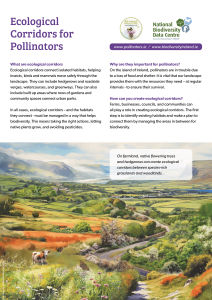The National Biodiversity Data Centre is delighted to release a new resource on ecological corridors for pollinators. This booklet provides an introduction to ecological corridors and tips on how to create them.
What are ecological corridors?
Ecological corridors connect isolated habitats, helping insects, birds and mammals move safely through the landscape. They can include hedgerows and roadside verges, watercourses, and greenways. They can also include built up areas where rows of gardens and community spaces connect urban parks.
In all cases, ecological corridors – and the habitats they connect – must be managed in a way that helps biodiversity. This means taking the right actions, letting native plants grow, and avoiding pesticides.
How can we create ecological corridors?
Farms, businesses, councils, and communities can all play a role in creating ecological corridors. The first step is to identify existing habitats and make a plan to connect them by managing the areas in between for biodiversity.
This booklet contains tips on creating ecological corridors in communities and on public land, with case studies and links to further resources.
Download the free booklet here: Ecological Corridors for Pollinators

